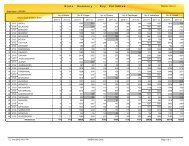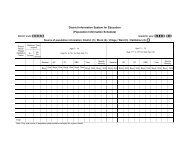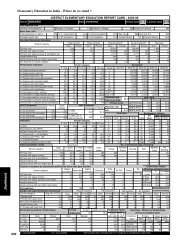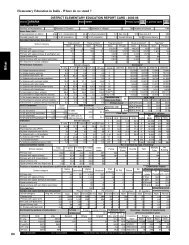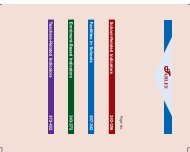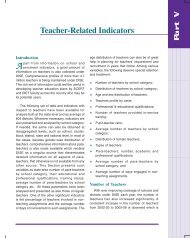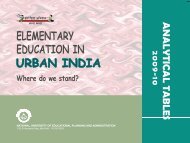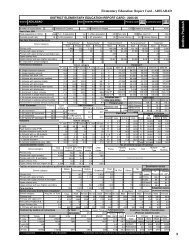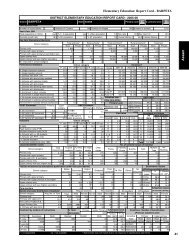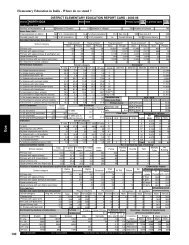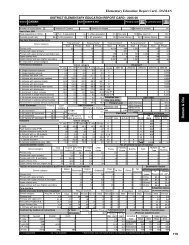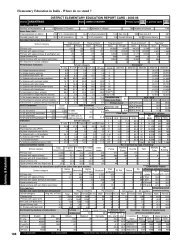Student Flow at Primary Level - DISE
Student Flow at Primary Level - DISE
Student Flow at Primary Level - DISE
- No tags were found...
Create successful ePaper yourself
Turn your PDF publications into a flip-book with our unique Google optimized e-Paper software.
32 <strong>Student</strong> <strong>Flow</strong> <strong>at</strong> <strong>Primary</strong> <strong>Level</strong>year 2005-06 are considered. This is supposed to give slightly a lowerpromotion and high drop-out r<strong>at</strong>e because it also considers those childrenwho successfully completed primary level but did not transit to GradeVI. It is better to consider the number of successful primary gradu<strong>at</strong>es butthe same for the year ‘t+1’, i.e. year 2005-06, is not available throughthe <strong>DISE</strong> d<strong>at</strong>a set. <strong>DISE</strong> collects inform<strong>at</strong>ion on number of gradu<strong>at</strong>es eachyear but of the previous academic year which in the present case is theyear 2004-05.One of the major limit<strong>at</strong>ions of the <strong>DISE</strong> enrolment d<strong>at</strong>a (in terms ofnumber of schools covered over time) is its inconsistency which is largelybecause of the coverage which has got expanded over a period of time. Ashas already been mentioned th<strong>at</strong> over a period of time, the number ofschools covered under <strong>DISE</strong> increased many-fold. This means th<strong>at</strong> eachyear new schools were covered under <strong>DISE</strong> the number of which variedfrom year to year and also from st<strong>at</strong>e to st<strong>at</strong>e. This is also true th<strong>at</strong> a fewschools covered in a year couldn’t be covered in the subsequent yearbecause of one or the other reason. Therefore, in the present exercise,grade-specific flow r<strong>at</strong>es, such as promotion, drop-out and repetition, aswell as averages of these r<strong>at</strong>es are calcul<strong>at</strong>ed based upon the gradespecificenrolment and repe<strong>at</strong>ers d<strong>at</strong>a of common schools only. Commonschools are the schools which have been covered both in the years 2004-05 and 2005-06 and have also submitted the enrolment and repe<strong>at</strong>ersd<strong>at</strong>a during these years. The number of common schools and percentageof such schools for the years 2004-05 and 2005-06 are presented in Table12 which suggests th<strong>at</strong> more than 88 percent of the total schools in 2005-06 are common compared to 83 percent during the previous year, i.e.2004-05. But in a few st<strong>at</strong>es, such as Delhi, Punjab and Sikkim, thepercentage of common schools is much lower than the average of alldistricts which indirectly suggests th<strong>at</strong> these st<strong>at</strong>es have re-initialisedschools and have given school identific<strong>at</strong>ion codes afresh. Needless tomention th<strong>at</strong> once the school identific<strong>at</strong>ion code is given, it is supposedto remain the same forever. Therefore, the flow r<strong>at</strong>es in case of thesest<strong>at</strong>es do not represent the entire st<strong>at</strong>e for the reason mentioned above.This also suggest th<strong>at</strong> about 9 out of 10 schools imparting elementaryeduc<strong>at</strong>ion covered under <strong>DISE</strong> are considered in calcul<strong>at</strong>ing flow r<strong>at</strong>es.This otherwise means th<strong>at</strong> as many as 914.8 thousand schools areconsidered in the calcul<strong>at</strong>ion which is a very large sample of the totalelementary schools, and therefore, the findings can easily be generalised.On the other hand, as many as 22 out of 29 st<strong>at</strong>es reported percentage ofcommon schools in 2005-06 above 80 percent. The percentage of suchschools is as high as 99.57 percent in Tripura and 98.26 percent in Himachal




